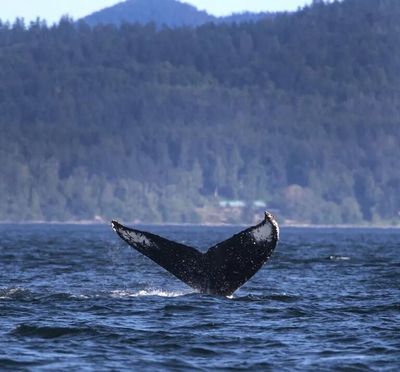There was a record number of sightings of these whales in the Salish Sea in 2022

A record number of Bigg’s killer whales and Humpback whales were spotted in the Salish Sea during 2022. The number of whales in the region has increased in the last few years, according to a news release from the Pacific Whale Watch Association.
There were 1,221 unique sightings of Bigg’s killer whales, formerly known as transient whales, in the Salish Sea. This is double the amount recorded from 2017, and an increase of 153 from 2021, according to the Orca Behavior Institute. A unique sighting is a sighting of a specific group of whales on a single day and does not include repeat reports of the same whales on the same day.
The salmon-eating Southern Resident killer whale population remains endangered and is rarely encountered by professional whale watchers, the association said. Bigg’s killer whales feed on marine mammals such as seals, porpoises and sea lions.
“Over the last 5 years or so we have seen a big spike in their (Bigg’s killer whales) presence here as the word spreads throughout the population, and a greater proportion of the population comes to make use of the Salish Sea for longer periods of time than they used to,” Monika Wieland Shields, co-founder of the Orca Behavior Institute, told the Herald in an email.
Humpbacks returning is also a notable achievement. In 2022, 396 individual humpback whales were photographed in the Salish Sea. This includes 34 mothers with calves, beating out the previous record of 21 humpback calves, set in 2021, according to the Pacific Whale Watch Association. This is the largest number of humpbacks recorded in over a century.
“The reason for their recovery is really quite simple, humans stopped hunting them, or their food,” Erin Gless, executive director of the Pacific Whale Watch Association, told the Herald in an email. “Humpback whales were completely wiped out from the Salish Sea by the early 1900s, but protections went into place in the U.S. and Canada in the late ’ 60s to stop the commercial hunting of humpback whales.”
There has also been an increase in protective actions taken by the Pacific Whale Watch Association, according to its release.
“Examples include stopping other vessels from speeding near whales, alerting ferries, cargo ships or military vessels when whales are nearby, retrieving harmful debris like derelict fishing gear and balloons and reporting entangled or injured wildlife to proper authorities,” the release said.
The release stated association members would make contact with vessels traveling near a pod of whales and were able to modify the behavior of other nearby vessels in 74% of interactions.
Whales in Bellingham Bay are uncommon, but the sightings have also been increasing over the last few years. It may become more common to see whales in the bay, Gless said in a previous Herald report.